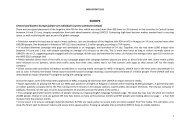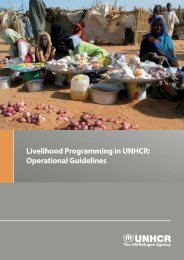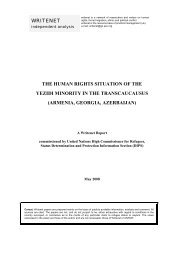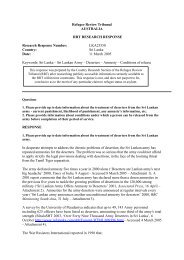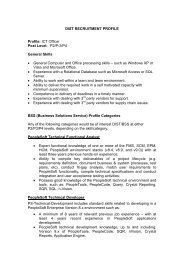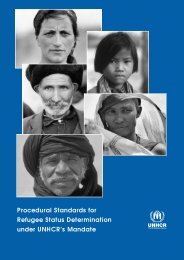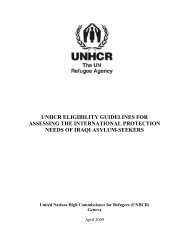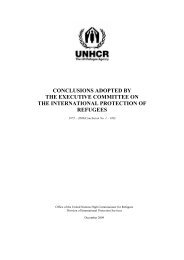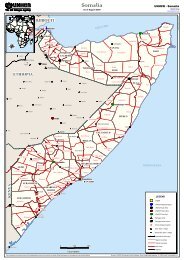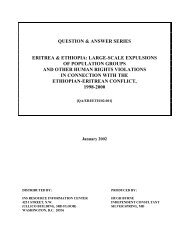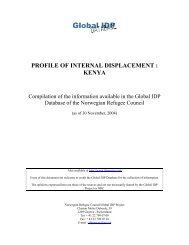UNHCR's ELIGIBILITY GUIDELINES FOR ASSESSING THE ...
UNHCR's ELIGIBILITY GUIDELINES FOR ASSESSING THE ...
UNHCR's ELIGIBILITY GUIDELINES FOR ASSESSING THE ...
You also want an ePaper? Increase the reach of your titles
YUMPU automatically turns print PDFs into web optimized ePapers that Google loves.
Estimates of the number of Yazidis range from 100,000 to as many as 800,000 people.<br />
Yazidis can mainly be found in Iraq, Syria and Turkey. 356 Only about ten percent of the<br />
Yazidis live in the Kurdish-administered areas, mainly in the Governorate of Dahuk,<br />
whereas the majority lives in so-called “disputed areas” in the Governorate of Ninewa, in<br />
particular in the areas of Jebel Sinjar and Shekhan, which have been subjected to the<br />
former regimes’ Arabization campaigns. 357 Jebel Sinjar was depopulated in 1965, 1973-<br />
1975 and 1986-1987, and the Yazidi residents of some 400 villages were forced to live in<br />
“collective towns”. 358 Their villages were either destroyed or given to Arab settlers. The<br />
Shekhan area was arabized as of 1975. 359 The Kurdish authorities have made it clear that<br />
they consider these areas as “Kurdish” and wish to incorporate them into the Region of<br />
Kurdistan. 360 Small Yazidi communities can also be found in urban settings, e.g. in the<br />
cities of Dahuk, Mosul and Baghdad. Yazidis also used to live in other cities of central and<br />
southern Iraq, e.g. in Hilla, Basrah and Nassriyah. 361<br />
The Yazidi religion is closed to outsiders as Yazidis do not intermarry, not even Kurds, nor<br />
do they accept converts. Accordingly, important parts of the Yazidi religious rituals have<br />
never been seen by outsiders and are, therefore, unknown. The Yazidis have never been<br />
Kurdische Studien, October 2005, p. 9-10, http://www.yeziden-colloquium.de/inhalt/gesellschaft/recht/<br />
Savelsberg_Hajo_Gutachten.pdf.<br />
355 Yazidis in Jebel Sinjar often speak Arabic; see Savelsberg and Hajo, ibidem, p. 11-12; Christine Allison,<br />
Yazidis, The Circle of Ancient Iranian Studies, http://www.cais-soas.com/CAIS/Religions/iranian/yazidis.htm,<br />
last modified 26 January 2007.<br />
356 The Religious Freedom Report puts their number at 650,000; see: USDOS, International Religious<br />
Freedom Report 2006 – Iraq, see above footnote 28. The Encyclopaedia Britannica estimates that there are<br />
less than 100,000 Yazidis in Iraq, Turkey, Syria, Armenia, the Caucasus and Iran; see: Encyclopaedia<br />
Britannica, Yazidi, http://concise.britannica.com/ebc/article-9383110/Yazidi [accessed January 2007]. The<br />
Encyclopaedia of the Orient provides a number of more than 700,000, including 500,000 in Iraq, 50,000 in<br />
Turkey and 30,000 in Syria; see: Encyclopaedia of the Orient, Yazidism, see above footnote 353. The Yazidi<br />
website Dengê Êzîdiyan claims that there are as many as 800,000 Yazidis, with around 550,000 in Northern<br />
Iraq; see Dengê Êzîdiyan [in German language], Fragen zum Yezidentum, Die Religion der Yeziden,<br />
http://www.yezidi.org/fragen_yezidentum.0.html [accessed January 2007]; there exists also a significant<br />
Yazidi Diaspora, in particular in Germany. According to the Yeziden Colloquium, more than 40,000 Yazidi<br />
live in Germany; see Yeziden Colloquium [in German language], Wir über uns, http://www.yezidencolloquium.de/ueber_uns.htm<br />
[accessed January 2007].<br />
357 See “De-Arabization”.<br />
358 Settlements built by the former regime during the Anfal campaign to which Kurds and others were<br />
forcibly relocated after their villages were destroyed.<br />
359 Irene Dulz, Siamend Hajo and Eva Savelsberg, Verfolgt und umworben: Die Yeziden im »neuen Irak« [in<br />
German language], published in: Kurdische Studien 4+5, 2004/2005, p. 1, http://www.yeziden-colloquium.de/<br />
inhalt/wissenschaft/Dulz_Savelsberg_Hajo_Yeziden.pdf.<br />
360 For example, the Unification Agreement of 21 January 2006, states the aim of “restoring Kirkuk,<br />
Khanaqin, Sinjar, Makhmour, and other Arabized areas to the embrace of the Kurdistan Region”; KRG,<br />
Kurdistan Regional Government Unification Agreement, 21 January 2006, http://www.krg.org/<br />
articles/article_detail.asp?LangNr=12&RubricNr=107&ArticleNr=8891&LNNr=28&RNNr=70. The draft<br />
Constitution for the Region of Kurdistan enshrines in Article 2(I): “Iraqi Kurdistan comprises the<br />
Governorate of Duhok within its present boundary, and the governorates of Kirkuk, Sulaimani, and Arbil with<br />
the 1968 borders and the districts (kaza) of Akre, Shaikhan, Sinjar, Tel Afar, Tilkef, Qaragosh and the sub<br />
districts (nahiya) of Zamar, Ba’shiqa, Aski Kalak in the Governorate of Nineveh and the districts of Khanaqin<br />
and Mandali in the Governorate of Diyali and the district of Badra and the subdistrict of Jassan in the<br />
Governorate of Wasit.”<br />
361 Savelsberg and Hajo, p. 6, see above footnote 354.<br />
77




